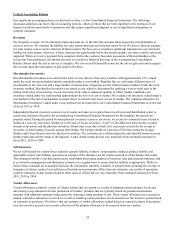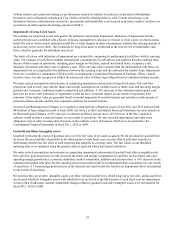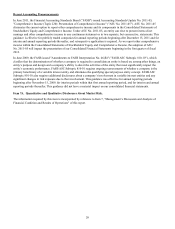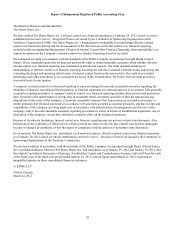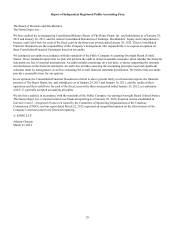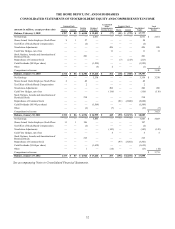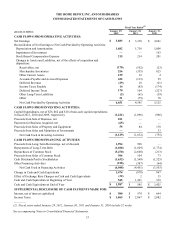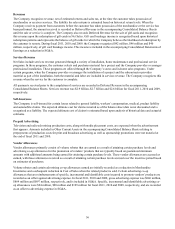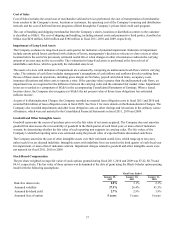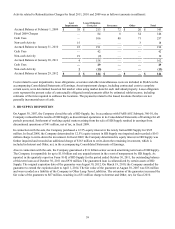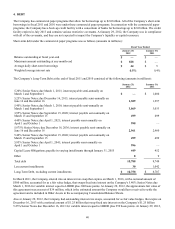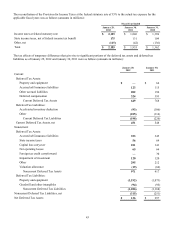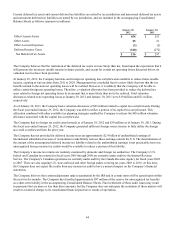Home Depot 2011 Annual Report Download - page 40
Download and view the complete annual report
Please find page 40 of the 2011 Home Depot annual report below. You can navigate through the pages in the report by either clicking on the pages listed below, or by using the keyword search tool below to find specific information within the annual report.
34
NOTES TO CONSOLIDATED FINANCIAL STATEMENTS
1. SUMMARY OF SIGNIFICANT ACCOUNTING POLICIES
Business, Consolidation and Presentation
The Home Depot, Inc. and its subsidiaries (the "Company") operate The Home Depot stores, which are full-service,
warehouse-style stores averaging approximately 104,000 square feet of enclosed space, with approximately 24,000 additional
square feet of outside garden area. The stores stock approximately 30,000 to 40,000 different kinds of building materials,
home improvement supplies and lawn and garden products that are sold to do-it-yourself customers, do-it-for-me customers
and professional customers. The Company also offers over 300,000 products through its website, homedepot.com. At the end
of fiscal 2011, the Company was operating 2,252 The Home Depot stores, which included 1,974 stores in the United States,
including the Commonwealth of Puerto Rico and the territories of the U.S. Virgin Islands and Guam ("U.S."), 180 stores in
Canada, 91 stores in Mexico and 7 stores in China. The Consolidated Financial Statements include the accounts of the
Company and its wholly-owned subsidiaries. All significant intercompany transactions have been eliminated in
consolidation.
Fiscal Year
The Company’s fiscal year is a 52- or 53-week period ending on the Sunday nearest to January 31. Fiscal years ended
January 29, 2012 ("fiscal 2011"), January 30, 2011 ("fiscal 2010") and January 31, 2010 ("fiscal 2009") include 52 weeks.
Use of Estimates
Management of the Company has made a number of estimates and assumptions relating to the reporting of assets and
liabilities, the disclosure of contingent assets and liabilities, and reported amounts of revenues and expenses in preparing
these financial statements in conformity with U.S. generally accepted accounting principles. Actual results could differ from
these estimates.
Fair Value of Financial Instruments
The carrying amounts of Cash and Cash Equivalents, Receivables and Accounts Payable approximate fair value due to the
short-term maturities of these financial instruments. The fair value of the Company’s Long-Term Debt is discussed in
Note 11.
Cash Equivalents
The Company considers all highly liquid investments purchased with original maturities of three months or less to be cash
equivalents. The Company’s cash equivalents are carried at fair market value and consist primarily of money market funds.
Accounts Receivable
The Company has an agreement with a third-party service provider who directly extends credit to customers, manages the
Company’s private label credit card program and owns the related receivables. The Company evaluated the third-party
entities holding the receivables under the program and concluded that they should not be consolidated by the Company. The
agreement with the third-party service provider expires in 2018, with the Company having the option, but no obligation, to
purchase the receivables at the end of the agreement. The deferred interest charges incurred by the Company for its deferred
financing programs offered to its customers are included in Cost of Sales. The interchange fees charged to the Company for
the customers’ use of the cards and any profit sharing with the third-party administrator are included in Selling, General and
Administrative expenses ("SG&A"). The sum of the three is referred to by the Company as "the cost of credit" of the private
label credit card program.
In addition, certain subsidiaries of the Company extend credit directly to customers in the ordinary course of business. The
receivables due from customers were $45 million and $42 million as of January 29, 2012 and January 30, 2011, respectively.
The Company’s valuation reserve related to accounts receivable was not material to the Consolidated Financial Statements of
the Company as of the end of fiscal 2011 or 2010.
Merchandise Inventories
The majority of the Company’s Merchandise Inventories are stated at the lower of cost (first-in, first-out) or market, as
determined by the retail inventory method. As the inventory retail value is adjusted regularly to reflect market conditions, the
inventory valued using the retail method approximates the lower of cost or market. Certain subsidiaries, including retail
operations in Canada, Mexico and China, and distribution centers, record Merchandise Inventories at the lower of cost or


